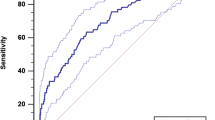Abstract
Background. Risk-adjusted mortality rates are used to compare quality of care of different hospitals. We evaluated the EuroSCORE (European System for Cardiac Operative Risk Evaluation) in patients undergoing isolated coronary artery bypass grafting (CABG).
Patients and method. Data of all CABG patients from January 2004 until December 2008 were analysed. Receiver-operating characteristics (ROC) curves for the additive and logistic EuroSCOREs and the areas under the ROC curve were calculated. Predicted probability of hospital mortality was calculated using logistic regression analyses and compared with the EuroSCORE. Cumulative sum (CUSUM) analyses were performed for the EuroSCORE and the actual hospital mortality.
Results. 5249 patients underwent CABG of which 89 (1.7%) died. The mean additive EuroSCORE was 3.5±2.5 (0-17) (median 3.0) and the mean logistic EuroSCORE was 4.0±5.5 (0-73) (median 2.4). The area under the ROC curve was 0.80±0.02 (95% confidence interval (CI) 0.76 to 0.84) for the additive and 0.81±0.02 (0.77 to 0.85) for the logistic EuroSCORE. The predicted probability (hazard ratio) was different from the additive and logistic EuroSCOREs. The hospital mortality was half of the EuroSCOREs, resulting in positive variable life-adjusted display curves.
Conclusions. Both the additive and logistic EuroSCOREs are overestimating the in-hospital mortality risk in low-risk CABG patients. The logistic EuroSCORE is more accurate in high-risk patients compared with the additive EuroSCORE. Until a more accurate risk scoring system is available, we suggest being careful when comparing the quality of care of different centres based on risk-adjusted mortality rates. (Neth Heart J 2010;18:355-9.)





Similar content being viewed by others
References
DuBois RW, Rogers WH, Moxley JH, et al. Hospital inpatients mortality: is it a predictor of quality. N Engl J Med. 1987;317:1674-80.
Jarman B, Gault S, Alves B, Hider A, Dolan S, Cook A, et al. Explaining differences in English hospital death rates using routinely collected data. BMJ. 1999;318:1515-20.
Jarman B, Bottle A, Aylin P, Browne M. Monitoring changes in hospital standardised mortality ratios. BMJ. 2005;330:329.
van den Bosch WF, Roozendaal KJ, Silberbusch J. Schommelende sterftcijfers. Medisch Contact. 2009:31.
Crommentuyn R. ‘Levens redden wil iedereen’. Britten tonen dat verlagen sterftecijfer niet moeilijk is. Medisch Contact. 2009:26.
Den Ouden AL, van der Wal G. Het gestandaardiseerde ziekenhuissterftecijfer (HSMR) bruikbaar voor het volgen van ziekenhuissterfte. Ned Tijdschrift voor Geneeskunde. 2008;152:1191-2.
van den Bosch WF, Graafmans WC, Pieter D, Westert GP. Hartcentra en het effect van bijzondere medische verrichtingen op het gestandaardiseerde ziekenhuissterftecijfer. Ned Tijdschr Geneeskd. 2008;152:1221-7.
Den Ouden AL, Nugteren WAH, Haeck J, Van den Berg, JMJ. Sterftecijfer niet afserveren. Medisch Contact. 2008;63:561.
Geelkerken RH, Mastboom WJB, Bertelink BP, Van der Palen J, Berg M, Kingma JH. Een onrijp instrument. Sterftecijfer niet geschikt als maat voor ziekenhuiskwaliteit. Medisch Contact. 2008;63:370-9.
Kool RB, Van der Veen AA, Westert GP. Sterftemaat is valide instrument. Medisch Contact. 2007;62:2090-91.
Van der Voort PHJ, De Jonge E. Sterfte als maat voor kwaliteit. Medisch Contact. 2007;62:1766-7.
Pronk E. Mortaliteit als maat - Sterftecijfers geven kwaliteit ziekenhuiszorg weer. Medisch Contact. 2005;60: 876-9.
Heijink R, Koolman X, Pieter D, Van der Veen A, Jarman B, Westert G. Measuring and explaining mortality in Dutch hospitals; the Hospital Standardized Mortality Rate between 2003 and 2005. BMC Health Services Research. 2008;8:73.
Parsonnet V, Dean D, Bernstein, AD. A method of uniform stratification of risk for evaluating the results of surgery in acquired adult heart disease. Circulation. 1989;701(suppl):13-112.
Higgins TL, Estafanous FG, Loop FD, Beck GJ, Blum JM, Paranandi L. Stratification of morbidity and mortality outcome by preoperative risk factors in coronary artery bypass patients. J Am Med Assoc. 1992;267:2344-8.
Roques F, Gabrielle F, Michel P, de Vincentiis C, David M, Baudet E. Quality of care in adult heart surgery: proposal for a self-assessment approach based on a French multicenter study. Eur J Cardiothorac Surg. 1995;9:433-40.
Pons JMV, Granados A, Espinas JA, Borras JM, Martin I, Moreno V. Assessing open heart surgery mortality in Catalonia (Spain) through a predictive risk model. Eur J Cardiothorac Surg. 1997;11:415-23.
Tu JV, Jaglal SB, Naylor CD. Multicenter validation of a risk index for mortality, intensive care unit stay, and overall hospital length of stay after cardiac surgery. Circulation. 1995;91:677-84.
Roques F, Nashef SAM, Michel P, Gauducheau E, de Vincentiis C, Baudet E, et al. Risk factors and outcome in European cardiac surgery: analysis of the EuroSCORE multinational database of 19030 patients. Eur J Cardiothorac Surg. 1999;15:816-23.
Nashef SAM, Roques F, Michel P, Gauducheau E, Lemeshow S, Salamon R. European system for cardiac operative risk evaluation (EuroSCORE). Eur J Cardiothorac Surg. 1999;16:9-13.
Ad N, Barnett SD, Speir AM. The performance of the EuroSCORE and the Society of Thoracic Surgeons mortality risk score: the gender factor. Interact CardioVasc Thorac Surg. 2007;7:192-5.
Nilsson J, Algotsson L, Hoglund P, Luhrs C, Brandt J. Early mortality in coronary artery bypass surgery: the EuroSCORE versus the Society of Thoracic Surgeons risk algorithm. Ann Thorac Surg. 2004;77:1235-9.
Lovegrove J, Valencia O, Treasure T, Sherlaw-Johnson C, Gallivan S. Monitoring the results of cardiac surgery by variable life-adjusted display. Lancet. 1997;350:1128-30.
Swets JA. Measuring the accuracy of diagnostic systems. Science. 1988;240:1285-93.
Geissler HJ, Holzl P, Marohl S, Kuhn-Regnier F, Mehlhorn U, Sudkamp M, et al. Risk stratification in heart surgery: comparison of six score systems. Eur J Cardiothorac Surg. 200;17:400-6.
Nissinen J, Biancari F, Wistbacka JO, Loponen P, Teittinen K, Tarkiainen P, et al. Is it possible to improve the accuracy of EuroSCORE? Eur J Cardiothorac Surg. 2009; June 10 (Epub ehead of print).
Author information
Authors and Affiliations
Additional information
Department of Cardiothoracic Surgery, Catharina Hospital, Eindhoven, the Netherlands
Department of Education and Research, Catharina Hospital, Eindhoven, and the Center of Research on Psychology in Somatic Diseases, Department of Medical Psychology, Tilburg University, the Netherlands
Department of Anaesthesiology, Catharina Hospital, Brabant Medical School, Eindhoven, the Netherlands and University Hospital Ghent, Ghent, Belgium
Rights and permissions
About this article
Cite this article
van Straten, A.H.M., Tan, E.M.E.S.H., Hamad, M.A.S. et al. Evaluation of the EuroSCORE risk scoring model for patients undergoing coronary artery bypass graft surgery: a word of caution. NHJL 18, 355–359 (2010). https://doi.org/10.1007/BF03091791
Issue Date:
DOI: https://doi.org/10.1007/BF03091791




